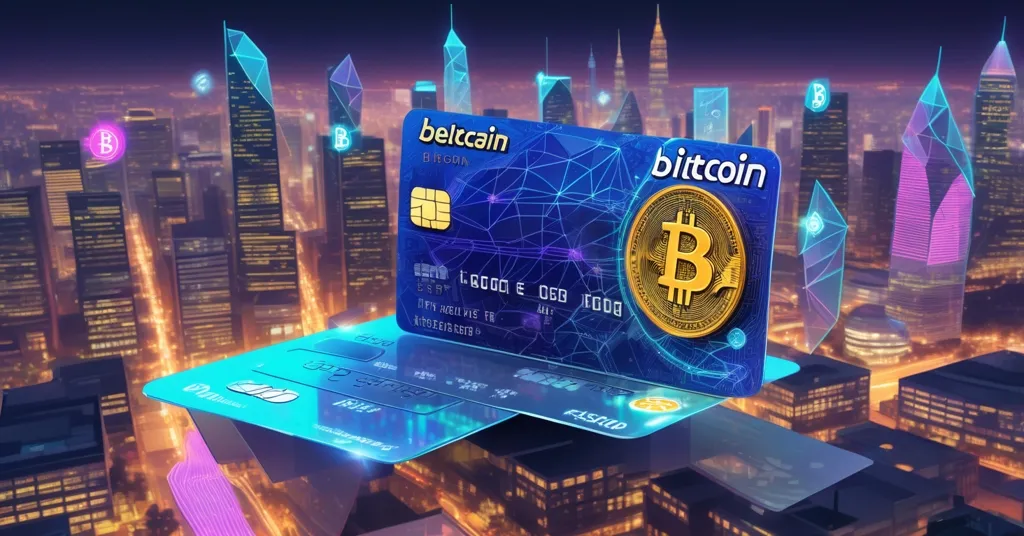Bybit Card Wins Mastercard’s Top Crypto Payment Award at EDGE 2025

Bybit Card Clinches Mastercard’s Best Crypto Payment Award at EDGE 2025: A Leap for Bitcoin and Beyond
Bybit, the heavyweight cryptocurrency exchange ranking second globally by trading volume, has just scored a major win: its Bybit Card was named the Best Performing Crypto Card by Mastercard at the EDGE 2025 forum. Held in the EEMEA region (Eastern Europe, Middle East, and Africa), this event spotlighted the future of payments, and Bybit’s recognition marks a significant milestone in merging digital assets with everyday financial systems.
- Top Accolade: Bybit Card awarded Best Performing Crypto Card by Mastercard at EDGE 2025.
- User Surge: Over two million cardholders since its 2024 global debut.
- Standout Features: Fiat-to-crypto spending, no annual fees, up to 8% APR on balances, and global ATM access.
Bybit Card: Bridging Bitcoin to Everyday Transactions
For those new to the crypto space, a crypto card is essentially a debit card linked to your digital asset holdings, allowing you to spend cryptocurrencies like Bitcoin (BTC) or Ethereum (ETH) as easily as fiat currency at merchants or ATMs. The Bybit Card, launched globally in 2024, has quickly amassed over two million users worldwide, a testament to the growing hunger for practical tools that make digital currencies spendable. This isn’t just a gimmick—it’s a functional tool that lets you pay for groceries with BTC or withdraw cash in local currency at supported ATMs across the globe. Integrated with the Mastercard network, it’s accepted at millions of merchants, meaning your corner store doesn’t need to know you’re paying with blockchain magic.
What sets the Bybit Card apart? Beyond the seamless fiat-to-crypto conversion (where your crypto is instantly converted to fiat at the point of sale), it offers perks that make traditional banks look stingy. There are no annual fees—a jab at the nickel-and-dime tactics of legacy finance—and users can earn up to 8% APR on their digital asset balances held with Bybit. Plus, there’s a 100% rebate on popular subscriptions like Netflix and Spotify, paid in crypto. The card supports a variety of cryptocurrencies for spending, including BTC, ETH, XRP, TON, USDT, USDC, MNT, and BNB, with cashback options in USDC, USDT, BTC, and AVAX. It’s almost as if Bybit is daring you to stick with your outdated bank card.
But how does this work under the hood? When you swipe the Bybit Card, the exchange handles the real-time conversion of your chosen cryptocurrency to fiat, ensuring the merchant gets paid in their local currency without a hitch. While Bybit touts no annual fees, users should be wary of potential hidden costs, especially during volatile market swings when conversion rates might not be in your favor. The 8% APR on balances sounds enticing, but sustainability is a question mark—high yields often come with risks tied to market downturns or platform solvency. Still, for Bitcoin enthusiasts, the ability to spend BTC directly without jumping through banking hoops aligns beautifully with Satoshi’s vision of peer-to-peer cash.
Mastercard’s Nod at EDGE 2025: A Stamp of Credibility for Crypto
The EDGE 2025 forum wasn’t just a gathering of fintech nerds—it was a deep dive into the future of payments, tackling innovations like agentic AI (think autonomous financial decision-making systems), embedded finance (integrating financial services into non-financial apps), stablecoins, and tokenization. Mastercard, a titan in the payment world, using this platform to crown Bybit Card as the top performer is a resounding endorsement. It’s not just a trophy; it’s a signal to the industry that crypto payment tools are no longer a fringe experiment but a viable piece of the financial puzzle.
“We are honored to receive this award from Mastercard, a global leader in financial innovation and a trusted partner in payment technology. The recognition validates Bybit’s vision to make crypto freedom a reality and digital assets more accessible for everyday users,” said Sophie Chen, Head of Marketing at Bybit Card and Pay.
This partnership isn’t a one-off. Mastercard has a history of dipping its toes into blockchain waters, from past collaborations with crypto firms to pilot programs for digital currencies. Their recognition of Bybit at EDGE 2025 underscores a broader acceptance of cryptocurrency as a legitimate payment method, especially as they push innovations like tokenization—a security measure replacing sensitive data, such as card numbers, with unique digital tokens to prevent fraud. With nearly 50% of their online transactions in Europe already tokenized and a goal of 100% by 2030, Mastercard is laying the groundwork for a payment ecosystem where blockchain tech could play a starring role. Imagine a world where your Bitcoin transaction is as secure as a credit card swipe, thanks to tokenization. That’s the future they’re betting on.
European Expansion: Riding the Wave of Regulatory Clarity
Bybit’s timing for growth couldn’t be sharper. In September, the Bybit Card launched across the European Economic Area (EEA), though it skipped a few countries like Croatia, Ireland, Romania, and Norway due to local regulatory quirks. This expansion taps into a region increasingly warming to crypto, driven by clearer rules and rising demand from both retail users and institutional players. Mazurka Zeng, CEO of Bybit EU, highlighted regulatory clarity as a key enabler, alongside grassroots adoption and growing interest from big money.
Europe’s crypto landscape is indeed shifting. The upcoming Markets in Crypto-Assets (MiCA) regulation, set to fully roll out by late 2024, aims to standardize rules for crypto across the EU, offering exchanges like Bybit a more predictable sandbox to play in. While this is a boon for legitimacy, it’s also a double-edged sword—compliance costs could squeeze smaller innovators out of the game. Still, for users in the EEA, the Bybit Card means spending Bitcoin or USDT at local shops without the headache of manual conversions or shady third-party services. It’s stealth adoption at its finest: merchants don’t even need to know they’re indirectly dealing with blockchain transactions, thanks to Mastercard’s infrastructure.
The Dark Side of Crypto Cards: Centralization and Privacy Pitfalls
Let’s pump the brakes on the hype train for a moment and get real. While the Bybit Card is a shiny step toward Bitcoin spending, it’s not without its baggage. Two million cardholders is a strong start, but it’s peanuts compared to the billions using Visa or Mastercard alone. Scaling this to true mass adoption isn’t just a tech problem—it’s an education and trust hurdle. Most people still think crypto is a scam or a speculative bubble, and no amount of Netflix rebates will change that overnight.
More critically, let’s call it what it is: relying on a centralized exchange like Bybit to manage your crypto spending is a gamble on privacy and control. You’re not holding your keys; they are. That’s a far cry from the decentralized ethos Bitcoin was built on. Are we really advancing freedom, or just swapping one middleman (banks) for another (exchanges)? Sure, Bybit’s security track record is solid for now, but centralized platforms are juicy targets for hacks, regulatory crackdowns, or internal mismanagement. And while Europe’s regulatory clarity helps, it also means more oversight—your transactions might be more traceable than you’d like if you value the anonymity crypto promises.
Then there’s the competition. Bybit isn’t the only player in the crypto card game. Coinbase Card offers similar fiat-to-crypto spending with a focus on user-friendly onboarding, while Binance Card boasts wider geographic reach in some regions. Wirex and other contenders are also vying for your wallet. Bybit’s edge lies in its no-fee model and high APR, but competitors might outshine it with broader coin support or lower conversion spreads. The “best performing” title from Mastercard is nice, but performance for whom—users, merchants, or Mastercard’s own metrics? We don’t have the full picture, and that’s worth chewing on.
Playing Devil’s Advocate: Are Crypto Cards Solving a Real Problem?
Here’s a contentious thought: are tools like the Bybit Card genuinely revolutionary, or just a flashy niche product for crypto geeks who already have fiat solutions? For many, traditional debit cards and mobile payments work just fine—why bother with the volatility of BTC or the learning curve of blockchain wallets? The counterargument is that crypto cards empower the unbanked or those in oppressive financial systems, but let’s be honest: most of Bybit’s two million users likely aren’t in that camp. They’re tech-savvy early adopters or speculators looking for convenience, not liberation.
From a Bitcoin maximalist lens, there’s also a tension. Supporting altcoins like ETH or BNB on the card fills practical niches—Ethereum’s smart contracts or stablecoins like USDT offer stability BTC can’t match for daily spending. But does this dilute Bitcoin’s dominance as the ultimate decentralized money? Shouldn’t the focus be on scaling solutions like the Lightning Network for instant, low-fee BTC payments instead of leaning on centralized exchanges for multi-coin support? It’s a debate worth having, even if altcoins undeniably broaden the appeal of crypto cards.
What’s Next for Crypto Payments and Blockchain Integration?
Zooming out, Bybit’s win at EDGE 2025 is a microcosm of a tectonic shift. Crypto exchanges aren’t just gambling dens for price speculators anymore; they’re becoming serious players in the payment ecosystem. With Mastercard’s backing, the Bybit Card could inspire more traditional finance giants to embrace blockchain payments, accelerating adoption faster than any viral meme coin. Imagine a future where Bitcoin’s Lightning Network integrates with crypto cards for near-zero fees, or where stablecoins backed by central bank digital currencies (CBDCs) become the default for tokenized transactions. That’s not sci-fi—it’s a plausible roadmap if trends like Mastercard’s 2030 tokenization goal hold.
Yet, the road ahead is littered with obstacles. Regulatory patchwork across regions could slow expansion—Europe’s MiCA might streamline things, but what about fragmented rules in Asia or the U.S.? Scalability remains a beast; can Bybit handle tens of millions of users without hiccups? And trust, the crypto industry’s Achilles’ heel, still looms large. Every hack, scam, or rug pull sets adoption back, no matter how slick the card looks. For now, though, spending your Bitcoin on a burger while banks sweat over their slow wire transfers is a small victory worth savoring. Will tools like this redefine money, or are we still tethered to financial gatekeepers with a crypto veneer? That’s the million-BTC question.
Key Questions and Takeaways on Bybit Card and Crypto Payments
- What makes the Bybit Card a game-changer for Bitcoin and crypto spending?
Its real-time fiat-to-crypto conversion, Mastercard’s global acceptance, zero annual fees, up to 8% APR on balances, and subscription rebates position it as a practical way to use Bitcoin and other digital assets daily. - Why does Mastercard’s award at EDGE 2025 matter for blockchain payments?
It’s a powerful endorsement from a payment industry leader, proving that blockchain-based solutions like crypto cards are gaining traction as credible alternatives in traditional finance. - How does Bybit’s European rollout signal crypto adoption trends?
Driven by regulatory clarity and rising demand, the expansion into the EEA shows Bitcoin and cryptocurrency inching toward mainstream acceptance in regulated markets, despite some regional gaps. - What’s the significance of Mastercard’s tokenization push for crypto’s future?
Tokenization enhances transaction security by replacing sensitive data with digital tokens, and with a 2030 goal for full adoption, it could boost confidence in crypto cards and stablecoin payments. - Are crypto cards like Bybit’s truly advancing decentralization?
While they ease Bitcoin spending, dependence on centralized exchanges raises serious concerns about privacy and control, suggesting true decentralization remains elusive despite innovative tools.



